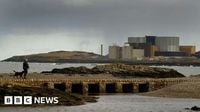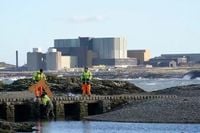Wylfa, a coastal site on the Isle of Anglesey in north-west Wales, is on the cusp of a new chapter in its storied nuclear history. According to reporting from BBC Wales and North Wales Live, the UK government is expected to confirm on Thursday, November 13, 2025, that Wylfa will be the chosen site for a new small modular reactor (SMR) nuclear power station. This decision, anticipated for years, could mark a significant boost for the local economy and the wider North Wales region.
The backdrop to this announcement is a complex mix of industrial legacy, political maneuvering, and international partnership. Wylfa was first built in the 1960s, officially coming online in 1971. For 44 years, it provided electricity and high-quality jobs, until its final reactor—Britain’s oldest at the time—was shut down in 2015. The closure marked the end of an era, as the site began the lengthy process of decommissioning, but the nuclear legacy and a skilled local workforce remained. As BBC Wales notes, the site’s history and expertise have made it an attractive candidate for new nuclear investment.
The decision to site the SMR at Wylfa comes after years of uncertainty. Previous plans for a full-scale nuclear plant at Wylfa collapsed in 2021, largely due to funding disagreements between the developer Hitachi and the UK government. That setback was a blow to the island’s economy and job prospects, leaving the community wary of more broken promises. As Llinos Medi, MP for Ynys Môn, told North Wales Live, “An announcement on Wylfa has been long awaited, so this expected announcement would be a major step forward. It reflects years of engagement by local businesses, industry experts, and the local Council in highlighting the site’s unique potential as one of Europe’s best locations for new nuclear.”
Yet, Medi also injected a note of caution: “We have been here many times before – so the people of Ynys Môn will rightly treat this story with caution until we see concrete action. We await further details to see how this announcement will secure high-quality, long-term jobs, and ensure local supply chains benefit from any development. This is a real opportunity to deliver a transformative project that strengthens energy security and benefits local communities, while fully respecting the Island’s environment, culture, and Welsh language.”
The SMR project is the result of a £2.5 billion partnership between the UK government and Rolls Royce, signed earlier in 2025. Ministers had been weighing whether to build at Anglesey or Oldbury in Gloucestershire, but recent concerns about flood risk at Oldbury pushed Wylfa to the front of the queue. The Department for Energy Security and Net Zero has yet to comment officially, but the decision appears all but certain.
The choice of SMR technology is significant. Unlike traditional gigawatt-scale nuclear plants, SMRs are manufactured in factories as modules and then assembled on-site, allowing for quicker and cheaper installation. Each SMR is capable of powering around one million homes. While the exact number of reactors to be built at Wylfa is not yet known, the site is believed to be able to accommodate more than one. The government hopes the new plant will provide up to 900 full-time jobs and several thousand more during construction, according to BBC Wales.
However, the SMR approach is not without its critics—or at least, its skeptics. Some, including US ambassador to the UK Warren Stephens, have advocated for a larger gigawatt-scale nuclear plant at Wylfa, which could power three million homes and bring even more jobs and investment. Writing in the Daily Telegraph, Stephens argued, “The UK has an immediate opportunity to capitalise on this momentum by designating the Wylfa site in north Wales for a gigawatt-scale nuclear project. Such a project would create thousands of jobs, provide affordable baseload power, and reduce reliance on weather-dependent or geopolitically vulnerable energy sources. Importantly, private investors are prepared to fund the majority of the project, minimising the need for taxpayer contributions.”
This endorsement from the US ambassador is more than just words—it reflects a broader UK-US partnership on nuclear technology, highlighted by a £76 billion agreement between the two countries in September. The Department for Energy Security and Net Zero welcomed the collaboration, stating, “We are launching a golden age of nuclear because by taking back control of our energy we will protect family finances, boost energy security and create thousands of jobs.”
For the Welsh government, nuclear power is seen as a crucial part of the transition away from fossil fuels. A spokesperson reiterated, “Nuclear energy is part of our plan to move away from fossil fuels, using both large-scale and small modular reactors. Wylfa is particularly well placed to attract investment in new nuclear plants because of its nuclear legacy and highly skilled local workforce. We continue to work with the UK government to ensure Wales’ potential in this sector is fully realised.”
Still, the debate over the right scale and type of nuclear development at Wylfa continues. Industry sources have suggested that building a gigawatt-scale plant at Wylfa would represent “generational transformational change,” but also cautioned that installing an SMR first might complicate future efforts to add a larger plant to the site. “It would not be the end of the world if the government chose to put an SMR at Wylfa, but it could snooker the site in the longer term,” one source told BBC Wales.
Local politicians, too, are keenly aware of both the opportunities and the risks. Rhun ap Iorwerth MS, speaking to North Wales Live, pointed out, “People on Ynys Môn have been led down this path by successive UK Governments in the past, only for the rug to be pulled from under their feet at the last minute. That mustn’t be repeated again. I’ve made it my priority always to find ways of ensuring that our community’s interests are at the very heart of a Wylfa development, both in terms of maximising opportunities and mitigating the challenges that inevitably come with a project of this size and nature.”
The political context is impossible to ignore. Any announcement by the UK Labour government, especially in the run-up to a much-anticipated budget and with a Senedd election looming in Wales, will be seized on and analyzed by all sides. Labour in Wales is fighting to hold on to power, and delivering tangible investment and jobs to Anglesey could prove pivotal.
Wylfa’s journey has been a long and winding one, marked by moments of hope and disappointment. As the island waits for Thursday’s confirmation, the stakes are high—not just for the local community, but for the UK’s energy future and its ability to deliver on promises of a new nuclear golden age. The decision on Wylfa will resonate far beyond the shores of Anglesey, shaping the region’s economy, energy security, and political landscape for years to come.

